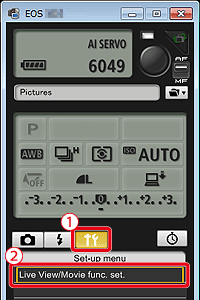Giải pháp
What is Remote Live View Shooting?
You can operate your camera remotely from EOS Utility Ver.3.x and shoot still photos and movies while looking at the subject on the EOS Utility Ver.3.x screen. Also, the captured still image is directly saved on your computer; therefore, you can check it with Digital Photo Professional Ver.4.x.
After shooting a movie, you can download the image data from the camera's memory card to a computer and save them in a selected folder.
This page describes how to shoot still photos and movies remotely using the Remote Live View function in default settings.
For details on how to change settings to enable Remote Live View shooting, please refer to the camera’s instruction manuals (included on the CD-ROM).
Preparing for Live View Shooting
1. Connect your camera to the computer, and then set the camera's power switch to [ON].
For information on how to connect the camera with the computer, please see the "Related information" section at the end of the page.
2. Set the lens focus mode switch to [AF].
3. Once EOS Utility Ver. 3.x starts, click [Remote shooting].
4. The capture window appears.
Click or right-click the setting item (

) and select the setting
(*1, *2).

*1 : If you checkmark [Change settings using mouse wheel on capture screen] on the [Remote Shooting] tab sheet on the [Preferences], you can also select settings with the scroll-wheel on your mouse. You cannot use the scroll-wheel in the mirror lockup menu or under [Image saving location].
*2 : You can right-click the Exposure level/AEB level item and perform AEB setting using the [Shift] key + scroll-wheel.
IMPORTANT
- You cannot perform RAW processing. If you connect the camera to your computer during in-camera RAW processing, the camera and computer will connect after you finish processing.
NOTE
- The settings that cannot be set in the capture window can be set by operating the camera.
- Self-timer shooting is also possible.
- You can also use mirror lockup with remote shooting. (You cannot take test shots after setting mirror lockup.)
- Mirror lockup settings are available when the camera mode is P, Tv, Av, M, or B.
- You can select the release timing after the mirror lockup to take a picture. Timing can be selected from 1/8 second later, 1/4 second later, 1/2 second later, 1 second later, and 2 seconds later.
For details on shooting still photos, go to the
Shooting Still Photos section ; and for details on shooting movies, refer to the
Shooting Movies section.
5. Once you have proceeded up to Step 4, set the Live View function.
6. In the capture window, click (

) to display the [Set-up] menu, then click [Live View/Movie func. set.] (

) on the screen that appears.
7. The [Live View/Movie func. set.] window appears. Select [Enable] for [LV func. setting] (

) and the setting for [Exposure simulation] (

), then click the [OK] (

) button.
8. Click the [Live View shoot.] button.
IMPORTANT
You cannot operate the camera when the [Remote Live View window] is displayed. Pressing the camera's [

] (Live View shooting) button will also display the Live View image on the camera's LCD monitor, allowing you to view the image while controlling the camera.
NOTE
- You can shoot by operating the capture window, even if the [Remote Live View window] is not displayed.
- To perform exposure simulation with [Remote Live View window] or enable display of histograms, set your camera’s Custom Function [Live View exposure simulation] to [Enable].
- During mirror lockup, the mirror lockup icon blinks.
9. The [Remote Live View window] appears, so drag the (

) enlargement display frame to move it to the position where you want to focus.
10. Click [ON] in the [Focus] window.
- AF is executed.
- When focus is achieved, the camera makes a beeping sound and the AF point turns green.
- If focus is not achieved, the AF point turns red.
11. When focus is achieved and the camera is ready for shooting, click the camera release button to shoot.
12. The captured images are transferred to the computer and displayed in the [Quick Preview] window.
- On computers with Digital Photo Professional Ver.4.x installed, the program starts up automatically when all the images have been downloaded, and the downloaded images are displayed.
This completes the explanation of still photo shooting operations with Remote Live View.
REFERENCE
- You can also shoot using the [space] bar on the keyboard.
- You can change the software that starts up automatically when remotely shot images are transferred to your computer from Digital Photo Professional Ver.4.x to other software in preferences ([Linked Software] tab sheet).
5. Once you have proceeded up to Step 4, click [

].
Set your camera’s Live View shooting/Movie shooting switch to [

].
IMPORTANT
- You cannot operate the camera when the [
 ] button is clicked. To operate the camera, click the [
] button is clicked. To operate the camera, click the [  ] button again or close the [Remote Live View window].
] button again or close the [Remote Live View window].
- You cannot shoot movies using Remote Live View function when EOS Utility Ver.3.x is wirelessly connected to the camera.
6. The [Remote Live View window] appears, so drag the (

) enlargement display frame to move it to the position where you want to focus.
7. Click [ON] in the [Focus] window.
- AF is executed.
- When focus is achieved, the camera makes a beeping sound and the AF point turns green.
- If focus is not achieved, the AF point turns red.
8. Set the movie functions on the capture window.
8-1. Click

to display the [Set-up menu], and then click [Live View/Movie func. set.] (

).
9. The [Live View/Movie func. set.] window appears, select the format, select the [movie rec. size] from the list box (

), then click [OK] (

).
REFERENCE
The following movie compression formats can be selected.
- ALL-I (I-only): Compresses one frame at a time for recording. Although the file size will be larger than with IPB, the movie will be more suited for editing.
- IPB: Compresses multiple frames at a time efficiently for recording. Since the file size will be smaller than with ALL-I, you can shoot longer.
10. Click the [

] and begin shooting.
- At the bottom left of the [Remote Live View window], a [
 ] icon and the recording time are displayed.
] icon and the recording time are displayed.
- Click the [
 ] again to end shooting.
] again to end shooting.
11. When the [Remote Live View window] closes, the following window appears if some image data remains to be downloaded to your computer. Select [Download].
12. After you click the [Download], the file names of the image data shot in movie mode (movie/still image) appear in a list.
After specifying [Destination Folder] and [File Name], click the [Download] in the window, and image data will be downloaded from the camera's memory card to your computer. Image data having a check mark removed from its file name are not downloaded. Afterward, when downloading image data to your computer from the camera's memory card, please refer to the camera’s instruction manuals (included on the CD-ROM).
This completes the explanation of movie shooting operations with Remote Live View.


 ) and select the setting (*1, *2).
) and select the setting (*1, *2).
 ) to display the [Set-up] menu, then click [Live View/Movie func. set.] (
) to display the [Set-up] menu, then click [Live View/Movie func. set.] ( ) on the screen that appears.
) on the screen that appears.
 ) and the setting for [Exposure simulation] (
) and the setting for [Exposure simulation] ( ), then click the [OK] (
), then click the [OK] ( ) button.
) button.

 ] (Live View shooting) button will also display the Live View image on the camera's LCD monitor, allowing you to view the image while controlling the camera.
] (Live View shooting) button will also display the Live View image on the camera's LCD monitor, allowing you to view the image while controlling the camera. ) enlargement display frame to move it to the position where you want to focus.
) enlargement display frame to move it to the position where you want to focus.



 ].
]. ].
].
 ] button is clicked. To operate the camera, click the [
] button is clicked. To operate the camera, click the [  ] button again or close the [Remote Live View window].
] button again or close the [Remote Live View window]. ) enlargement display frame to move it to the position where you want to focus.
) enlargement display frame to move it to the position where you want to focus.

 to display the [Set-up menu], and then click [Live View/Movie func. set.] (
to display the [Set-up menu], and then click [Live View/Movie func. set.] ( ).
).
 ), then click [OK] (
), then click [OK] ( ).
).
 ] and begin shooting.
] and begin shooting.
 ] icon and the recording time are displayed.
] icon and the recording time are displayed.  ] again to end shooting.
] again to end shooting.
